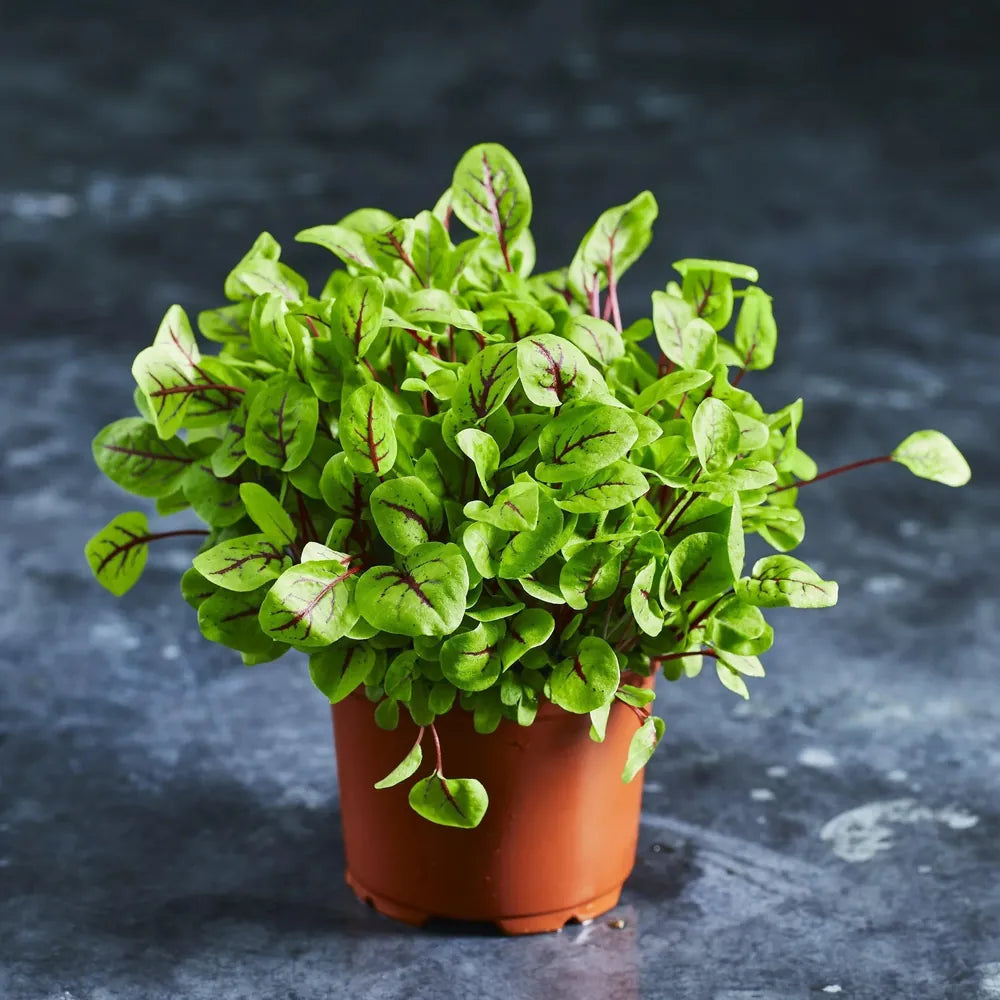Red Vein Sorrel Seeds Specifications
-
Rumex sanguineus
- Variety – Sorrel Seeds – Red Veined
- Also Known As – Spinach Dock, Narrow-leaved Dock
- Seeds per Gram – 1200–1500
- Colour – Lime-green leaves with bold red veins
- Texture – Slightly savoyed, juicy stems with baby-spinach palatability
- Flavour – Mild sour-lemon, refreshing citrus tang
- Germination Rate – High (88%+)
- Germination Time – 5–10 days
- Days to Maturity – 20–28 days to full size
Red Vein Sorrel Microgreens Are A Chef’s Favourite
Bring gourmet flair and vibrant colour to your kitchen with our premium Red Vein Sorrel Seeds for Microgreens. Also known as Spinach Dock or Narrow-leaved Dock, this variety is prized for its tart, lemony flavour that some describe as similar to kiwi fruit or strawberry. With lime-green leaves and bold red veins, sorrel microgreens are among the most striking micro herbs in the culinary world.
Why Grow Red Red Vein Sorrel Microgreens?
- Beautiful & Unique: Bright green leaves with vivid blood-red veins — a true showpiece on the plate.
- Zesty Flavour: Tart, lemony taste with subtle hints of kiwi or strawberry; balances rich or creamy dishes perfectly.
- Chef’s Favourite: Widely used as a garnish and micro-herb in fine dining.
- Nutritious: A source of vitamins A, C, and K, antioxidants, and minerals.
- Versatile: Enjoy as microgreens, micro-herbs, or grow to full leafy maturity.
How To Grow & Harvest Red Vein Sorrel
Sorrel takes more patience than fast microgreens, but the results are spectacular. Follow these steps for success:
- Medium: Best grown in soil, coco fibre and vermiculite. Hydroponics are not recommended but possible.
- Seeding Rate: Sow approximately 20–30 seeds in a 10 cm pot, spacing them well to allow airflow and room for development. Once the seedlings emerge, you can thin them to about 10 evenly spaced plants (optional) you may like them thicker, which is okay. By the time they reach full microgreen size, these thinned seedlings will have filled the space nicely.
- Pre-soak: Not required.
- Germination: Keep evenly moist and cover lightly with vermiculite or coco fibre. Seeds germinate in 5–10 days.
- Light: Provide bright indirect light or LEDs once sprouted. Strong light deepens the red veining.
- Watering: Mist regularly until sprouting (1-2cm), then switch to bottom watering to reduce fungal risk.
- Growth: Expect 20–30 days for harvestable shoots.
- Harvest Time: Cut when seedlings reach 6–8 cm tall and veins show deep red contrast (25–30 days).
- How to Harvest: Snip just above the soil line with scissors. Avoid pulling roots to keep harvest clean.
- Storage: Best used fresh; store up to 7 days in a sealed container in the fridge.
- Troubleshooting: Prevent damping off with fresh soil, or sterile grow mediums like coco peat and vermiculite, good airflow, and start bottom watering when seedlings reach a few centimetres. Also avoid waterlogged media and over watering.
Explore our Microgreens Seeds Collection or try them alongside Red Amaranth Seeds for Microgreens for a colourful contrast.
Live Rates – Weight & Destination Based
Shipping is automatically calculated at checkout based on your order’s weight and delivery address. We use real-time rates from Australia Post and other carriers to provide the most accurate cost.
Handling Time
Orders are packed and dispatched within 0–2 business days (Monday–Friday).
Estimated Delivery Time
Transit times depend on your location:
• Metro areas: usually 2–3 business days
• Regional/rural areas: 5–10 business days
• WA & TAS: may take longer due to state biosecurity inspections
Tracking
All orders include tracking. You’ll receive an email with your tracking link once your parcel has shipped.
Authority to Leave (ATL)
Couriers may leave parcels in a safe place if you are not home. Please provide delivery instructions at checkout if you prefer otherwise.
Pickup Option (Riverstone, NSW)
Please place your order on our website and select “Pick up” at checkout. Wait for us to contact you to confirm and arrange a pickup time. Do not come to our warehouse without an appointment — pickups are strictly by arrangement only. Allow 2–3 business days for preparation; we’ll notify you when your order is ready.
Biosecurity (WA & TAS)
Certain seeds are restricted under state biosecurity laws. Customers are responsible for ensuring products comply with local regulations. Please check with the WA Department of Primary Industries and Regional Development or the Tasmanian Department of Natural Resources and Environment before ordering.
For the full details, see our Shipping Policy.
No Change-of-Mind Returns
We do not accept returns or refunds for change-of-mind purchases.
No Exchanges
We do not accept product exchanges. All sales are final unless covered by Australian Consumer Law.
Your Rights Under Australian Consumer Law
Your ACL rights still apply. You’re entitled to a refund or replacement if your item is faulty, misdescribed, or incorrect. Please contact us within 7 days of delivery with your order number and photos if applicable. Once approved, we will provide a prepaid return label and process a refund or replacement. Refunds are issued to your original payment method within 10 business days.
90-Day Seed Germination Guarantee
If your seeds fail to germinate within 90 days of purchase, we will re-test the batch. If our test confirms poor germination, we will provide a refund or replacement. Seeds must be stored and used according to our instructions; please retain packaging or batch details if available.
For the full policy text you can also see our policy page at /policies/refund-policy.
Seed FAQ
Seeds don't expire, but their ability to sprout weakens over time. With proper storage, your seeds will remain viable for years, ensuring a high germination rate for every batch of fresh sprouts.
Key Storage Tips:
- ✅ Keep it Cool, Dry, and Dark: The best place to store seeds is in a location that's away from heat, light, and humidity.
- ✅ Use an Airtight Container: Jars or sealed bags are ideal. For extra protection against moisture, you can add a silica gel packet.
- ✅ Consider Refrigeration: For long-term storage, keeping seeds in the fridge or freezer is a great option. Just be sure to let them return to room temperature before you use them.
Sprouting Seed Viability Guide
Here's how long you can expect some of our most popular seeds to last when stored correctly:
- 1–2 Years: Mung beans, peas, lentils, and chickpeas.
- 3–4 Years: Alfalfa, radish, fenugreek, and mustard.
- 4–5 Years: Broccoli, wheatgrass, sunflower, buckwheat, and clover.
If you're unsure about older seeds, you can perform a simple germination test. Place a few seeds on a damp paper towel inside a sealed bag. Keep them moist and check the number of sprouts after 5–10 days to see if they are still viable.

